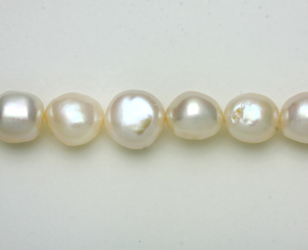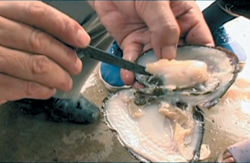SERIES 1: How to Shop for Pearls
Part 4 – Specifics for Picking Freshwater Pearls
Now that we know main qualities to look for in any pearl type, we can look more in-depth to learn what factors to look for in each specific pearl type. First we’ll start with the most common in the market, the Freshwater pearl.
A little background helps in understanding why we look for different qualities in different types of pearls. Freshwater pearls are the least expensive of all the pearls, and this is due to the way they are cultured.Freshwater pearls are cultured in a mussel that allows from 24-40 pearls to grow in one shell!
This can’t be done with any other pearl type, and thus, Freshwater pearls are indisputably the most prevalent in the market. Culturing Freshwater pearls is also unique from other types in that they are cultured with a piece of tissue instead of a round bead. This causes Freshwater pearls to very rarely be round and to be virtually solid nacre. That is why roundness is an important factor in choosing a high-quality Freshwater strand, and nacre thickness is not relevant.
Since luster and blemishing are important for all pearl types, we keep those qualities in mind when we focus on shape for Freshwater pearls. Freshwaters can come in shapes from baroque (an indefinable shape), oval, potato, near-round, to very round.

These Freshwater pearls lack a round shape and could be described as baroque, button, or off-round in shape.
While some people enjoy the baroque shapes that Freshwaters come in, most often people are looking for round pearls. Potato pearls are the least round, that are trying to be. Semi-round or near-round will be just slightly not round to the eye. A round or very round Freshwater will be round to the naked eye, but when measured may still not be exactly round. Very round Freshwaters will make the highest quality strand if they still have good luster and little blemishing.
Generally, if a pearl has good luster, then it probably has thick nacre. Though nacre thickness isn’t relevant for Freshwater pearls, (unless it has chips or peeling in the nacre which is BAD!!) luster is still an important factor. Freshwater pearls’ luster is generally less sharp than the luster of the other pearl types, excluding South Sea pearls. If comparing the luster of a high-quality Akoya strand to the luster of a high-quality Freshwater strand, the Akoya luster is generally going to be brighter, sharper, and more distinct. So always compare pearls within the same pearl family. Freshwater luster will have a more overall shininess, instead of the sharp reflections in the surface of the pearl. A high luster strand will also have a hint of iridescence, which is also sometimes referred to as orient. This iridescence is similar to the rainbow of colors that oil on the ground appears to have. This is a very desired quality in pearls, as it gives the pearls a richness and depth that can’t duplicated.

Different colors of Freshwater pearls - Pink, White, Black, and Chocolate. The pink and white are natural colors. The black and chocolate have been color-treated.
When buying different colors of Freshwaters, I feel it is important to know if they are naturally occurring colors, or if the pearls are dyed. Freshwater pearls come in a range of natural colors like pink, peach, apricot, bronze, lavender, gray, white, and many shades in between those colors. The colors may vary in brightness or intensity, but will generally be within the pastel family. Black Freshwater pearls are always dyed and so are chocolate colored ones. But Freshwater pearls are often in dyed in every color of the rainbow so make sure that the dealer is open about what they are selling. When choosing pearls of any color though, I would always compare the strands on your skin because even slight variations in pearl colors can make a big difference in how the pearls complement your skin tone.

